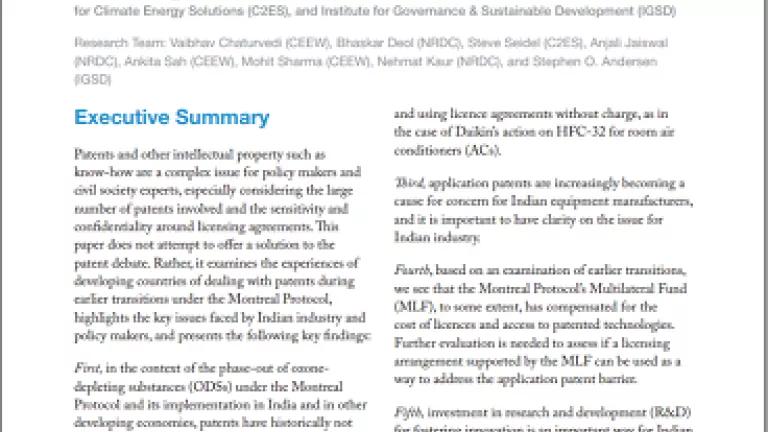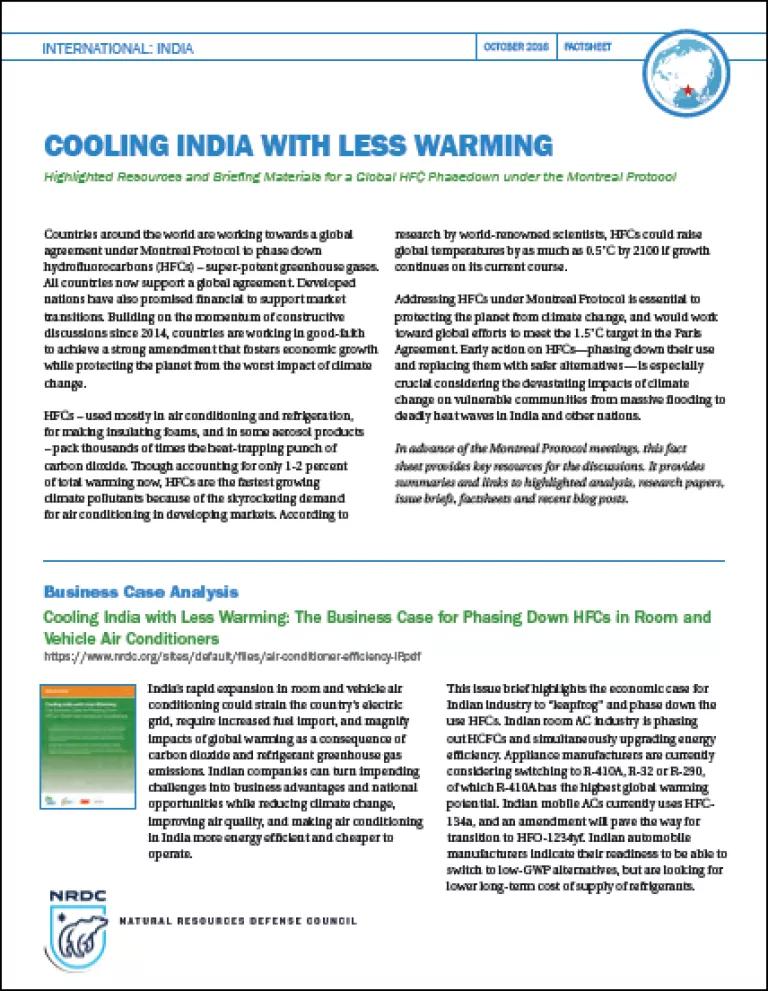
More than 150 countries kicked off talks to phase down hydrofluorocarbons (HFCs) this week, gathering in Kigali, Rwanda, hoping to reach a strong agreement to phase down these super-potent heat-trapping gases—and quickly.
This meeting is high stakes. The global community has an opportunity to take the next biggest step after the Paris Agreement to reduce climate change that threatens us all. If it fails, however, growing use of HFCs could undermine the progress we’ve made. I’m in Kigali as an observer and offer the following as some of the key points to watch.
Key high-level government officials, including President Paul Kagame of Rwanda, U.S. Secretary of State John Kerry, and Indian Minister of Environment Anil Madhav Dave, will arrive later this week as it nears time for the Montreal Protocol negotiators to reach agreement and close a second major global climate agreement building on the historic Paris Agreement.
HFCs—used in air conditioners, refrigerators, insulating foams, some aerosols, and other products—have up to 10,000 times the global warming potential of carbon dioxide. Though accounting for only 1-2 percent of total global warming now, HFCs are the fastest growing climate pollutants because of the skyrocketing demand for air conditioning and refrigeration in developing markets such as India. Addressing HFCs under the Montreal Protocol is essential to protecting the planet from climate change, and could contribute savings of up to half a degree towards the 1.5˚Celcius pathway outlined in the Paris Agreement.
Rwanda’s Minister for Natural Resources, Vincent Biruta, started the meeting earlier this week by urging countries to cooperate on a strong HFC phase down. Early in the discussions, government officials and experts seized on three major issues: when to start the HFC phase down (baseline and freeze year); fast-start funding for energy efficiency; and technological updates that build the case for fast action.
Start Date for Phasing Down HFCs
One of the key issues in Kigali is determining the start date for phasing down HFCs. Countries first need to agree to a “baseline” that sets the reference level for the cuts. Then, countries agree to a “freeze year” to start the actual phase down.
Developed countries are converging around a plan to start their phase downs in 2019. A phase down schedule would follow from there, culminating in an 85 percent cut in 2036. But talks aren’t finished yet. Developing countries and environmental groups, like NRDC, are urging developed countries to take faster action for greater greenhouse gas reductions and advance climate-friendly and energy-efficient cooling technologies worldwide.
The start date for developing countries is still coming together. They have proposed two groups with separate baselines: 2020-2022 for a majority including Brazil, South Africa, China, the African Group, Island Nations, Latin American countries, among others. Meanwhile, a smaller group, including India, Pakistan, and Middle Eastern countries, are proposing a baseline of 2024-2026. Once the baselines are agreed, negotiations on the freeze years start.
An early freeze year is critical. Delaying the HFC freeze drastically slows our ability to fight climate change. A late freeze on HFC use would allow massive amounts of additional climate pollution—equivalent to billions of tons of carbon dioxide—to be produced, used, and eventually released into the atmosphere, imperiling our climate. An earlier HFC freeze and phase down is possibly the easiest way to cut climate pollution.
Fast-Start Funding
To encourage early action, key developed countries and philanthropic foundations pledged $80 million in new funding in 2017, focused on developing markets with “fast-start support for implementation and energy efficiency improvements.” Combining benefits from energy efficiency and climate-friendly cooling is vital to developing markets with rising air conditioning demand. Efficient air conditioners put less stress on the electrical grid, reduce climate pollution from power plants, and save consumers money on their energy bills. Less electricity consumption also offsets the need to build new power plants and increases energy access across emerging economies.
The fast-start implementation and energy efficiency funds will likely be available only to parties that begin limiting their use of HFCs in 2024 or earlier. An ambitious agreement will ensure that emerging economies get support to sustainably meet cooling needs.
Technology Updates
Major updates on technology advancements are a central part of the discussion. Leading experts provided new analysis during a side event titled “Not-in-Kind Alternatives (NIK) to HFCs, Near-term HFC Reduction Opportunities, and Long Term Costs of Production of HFO-1234yf”. The discussion also included the preliminary estimates on the cost of producing HFO-1234yf, a key alternative used in automobile air conditioning. NRDC, and partners, the Institute for Governance & Sustainable Development (IGSD) and Center for Climate and Energy Solutions (C2ES) hosted the side event in Kigali.
The discussions identified opportunities to replace 50 percent of current HFC consumption with alternatives, such as hydrocarbons, carbon dioxide, ammonia, and leak reductions. An HFC amendment would also make leapfrogging to low-GWP alternatives more technically feasible and cost effective, and would dramatically increase the funding available to make leapfrog transitions.
During the event, NRDC and partners released two new papers as part of our series, Cooling India with Less Warming: Examining Patents for Alternatives to Hydrofluorocarbons and HFC Resources Fact Sheet.

Clearly, much work remains to reach an ambitious agreement in Kigali. Countries need to collaborate more closely to reach a strong HFC phase down. Market-leading developing countries like India, China, and others have a significant opportunity here—reaching a universal agreement and working towards an ambitious, climate-friendly pathway for developing countries would be a significant win for domestic markets and world-wide.
An early HFC phase down will foster sustainable growth with energy efficient, innovative technologies that provide jobs, increase energy access, and reduce air pollution while reducing consumer energy bills. Achieving an ambitious HFC phase down agreement under the Montreal Protocol is within reach and should be signed, sealed and delivered. It will accelerate the shift to a cleaner, more sustainable future of cooling across the world, and help protect millions, if not billions, of people from climate catastrophe.



